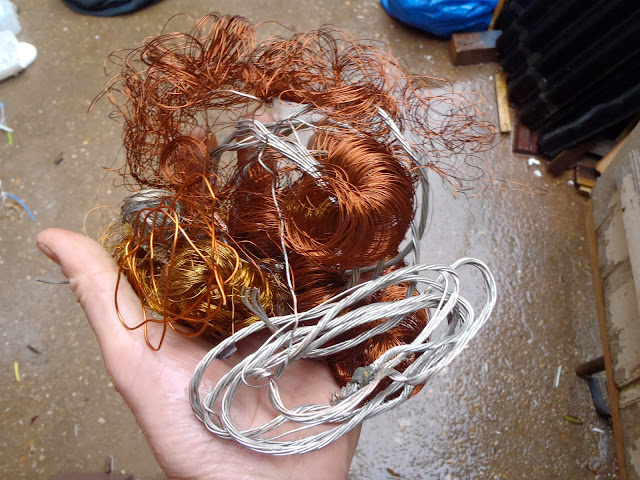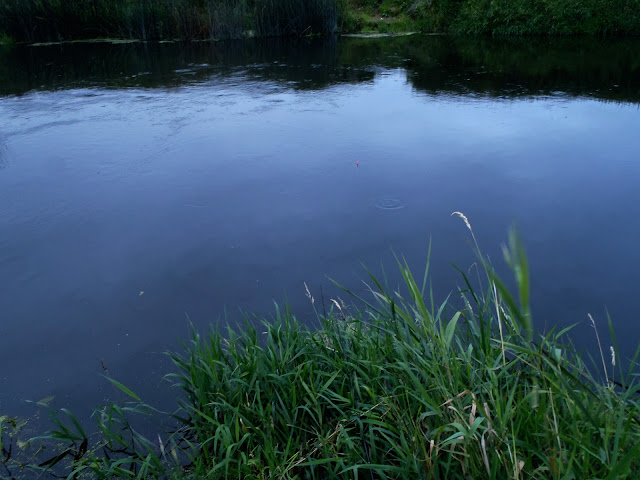As mentioned previously, the retrieval from other peoples rubbish piles of useful stuffs begged the question of what to do with that which was clearly of value but not directly to the toolery project and its immediate material requirements.
There were skips where the householder may just as well have pinned a tenner to the topmost thing in the dusty pile and had done with it...
The junction, the union, the chromed mixer tap,
The lock and its handle, the door hinge and latch,
The fingerplate, knocker and letterbox flapping
Of no use to me, but tot for the scrapping.
'Where's there's muck there's brass,' so they used to say when money was worth its own weight.
And today when a penny is plated steel and worth a fraction of face value?
Wherever there's skips there's fixtures cast in brass that can turn an honest one.
 |
| 'Mixed brass' because it has other metals in it |
Large and weighty stuff in the form of wet room fitments and door furniture, and at £2.55 per kilo current rate for 'Mixed Brass' up Milver Metals, it soon totted up to a handsome profit for the small effort in removing from the host objects.
But, wherever elements or elemental forces of nature are required to flow,
That's where the oysters are found containing the skip diver's pearl...
The transformer, the solenoid, the lock actuator,
The socket, the switch and the circuit breaker.
The pump and exchanger, the boiler and piping,
The flex and the cable, the earth with its striping.
The de-guassing coil and the yoke round the telly,
The hoover? The motor with coils in its belly.
These are the sources of scrap metal 'proper,'
In the wrecking apart for their No1 copper.
Hard work though, is copper.
None of that easy work of brass — all in the one heavy piece. A screw here or a bolt to turn there and what won't budge the wrecking driver prises.
Unless lucky enough to find a half coil of annealed tubing some fool DIY'er chucked out as surplus to requirements, with copper it's all hidden inside things or either it's joined to stuff. Very rarely is it gotten without effort.
 |
| The pearl. No 1 bright copper |
It pays the best return of all, though, with 'No 1 Bright' weighing in at £4.30 a kilo and on a good day with strong market demand, more still. However, hardly any is No1 as comes out the skip.
Some is 'No 2,' some 'Clean Heavy,' some 'Braziery.' That from transformers, yokes and motors with its varnish coat, 'Burnt Wire.'
No doubt there's yet more grades of copper I'm to discover the name of on tomorrow's chits...
 |
| Burnt wire. And though none is burnt as such, that's the grade for tinned or varnished copper wire unless it's cleaned up bright and shiny pink. No easy task |
All categories are priced in a descending scale down to measly amounts for unstripped X-mas lights and cabling, though all are as 99.9% pure as the driven snow without their contaminants, patinas, dirts, stains, paints, wrappings, base metal attachments and leaden solders, because anything less is an alloy and goes in the mixed brass bucket.
So, the first task of the canny scrapper, once a pile of various types of copper containing objects are amassed, is to sort, sift and grade and then remove as much plastic and tarnish and/or other metals as possible — taking that work from the middleman's hands — and thereby transforming as much as can be improved into the most valuable grades.
 |
| This is 'mixed brass' at best unless a great deal of work is spent separating the copper from it |
Within a month, what with all the lead, brass and copper and a big pile of aluminium weighed in for their poundage in raw worth and just about everything else got for free, the toolery was not just costing as little as humanly possible, it was costing much less than nothing. In fact it was in business to the tune of £213.03 and with scrap reserves in stock.
The trouble is...
Every now and then something glints and gleams and catches my magpie shed builder's eye.
A pile of not-for-the-scrapyard baubles accumulates and before long there's bits and bobs of brass and copper laying about the yard waiting for some fancied future usage.
There's this great big length of hexagonal brass from a fancy cistern handle mechanism that I just plain like in the bar for its aesthetic appeal alone.
Too nice for the crucible, I'm afraid...
Then there's a dirty and paint encrusted ten-foot length of heavy-walled inch and half copper piping sourced from a friendly 'vendor' outside his big Georgian house in our 'village' along with another thirty quids worth of unwanted copper and lead.
Well, I thought I'd keep it by...
....it weighed four kilos alone and would net £17 that very day with a buff and shine to No1 standard...
Nevertheless. Either future use or ornament, I wasn't entirely sure for which. But I just had to have it about the place just in case one or the other occurred to me later. As you do.
Enter cluttered yard, our missus...
Conversation follows.
"My, my, what a thick dirty plonker you have!"
"Such a filthy great stonker derives from a lav..."
"You're bound to the scrappy this moment then, honey?"
"I'm afraid this a copper of purpose, not money..."
"But whatever use can it serve, dear and fair?
Will you plumb, stoke a fire, take a bath en plein air?"
"Well, I would for the fun. Just the once. By moonlight...
but this pipe is reserved, I shall use it alright."
"Oh, I don't doubt you will, as the pole for your jack,
a novelty trombone or musket, perhaps?"
"I'll wait and I'll see what design is suggested,
a question for answer when I'm good and I'm rested."
But, what on earth 'other' tune can a pipe perform but what the piper blows down it? Unless it's a pole then a pipe is a pipe and it does what it designs. Its form is its function. There is no other for it.
Unless, that is, its formal singularity comes unravelled...
During one of those moments of bibulous clarity (clarety?) when admiring the sinuous curve created by a chance conjunction between window frames and an old carved oak headboard cut down for a door top, but all the while looking up at the unfixed, unfurnished, roof, and there taking stock of the job it must soon perform come Autumn — that important one of taking water away and down a convenient drain via a system of cheap and nasty plastic stuff hung from it...
It struck me that here in this length of filthy braziery lay the truly bling answer to both the functional and the aesthetic necessaries...
"If!"
I thought to myself,
'I split this 'ere copper pipe right down the middle and open it out — it will provide me a copper sheet.
The sheet thus provided can be formed to the shape required.
The shape required will be a semi-circle.
This 'ere pipe has a bore of an inch and a half...
C = π x d... (hero bounces upstairs to computer, calculates, then clatters back down again) and so this tube will provide me a sheet of copper...
4.71 inches wide by ten feet long... and that is just about right."
Cutting a piece off the end, I cut a lengthwise slit, annealed the piece on the camping stove, opened it out between fingers and thumbs and shaped it semi-circular like...
Viola! The gutter!
I set to work immediately
 |
| A tape line was fixed down the entire length along which a saw cut would be made. |
 |
| The slot was levered apart as I went to provide access for the saw frame. |
This process would continue the entire length and for as long as it took to complete, which was clearly going to be many, many hours when I'd only a foot of gutter but nine of pipe remaining in two.
Nevertheless, the process worked well and it looked both good and functional offered up against the facia board.
Of course. Being a frugal angler with a great annual cost in the way of lost weights, I didn't weigh in an ounce of the lead either...
 |
| 40lb of lead = 640 one ounce arsley bombs, or, 6 metres of flashing |
Methinks, "lead makes roof flashing. If I can make a gutter from an obdurate pipe I can make a plumb palace from a metal that melts in a pan on a kitchen stove. I shall boil it down and cast my own when a roll of the same retails £90 down B&Q. Less cost to the bad is more profit to the good, and after all, how difficult a thing can it be to do?"
Quite tricky indeed was the answer...
And then, just as I had three quarters the thinking but a tenth the work done of fixing the roof to my own satisfaction, it began to rain and looked as if it wouldn't stop for days.




















































